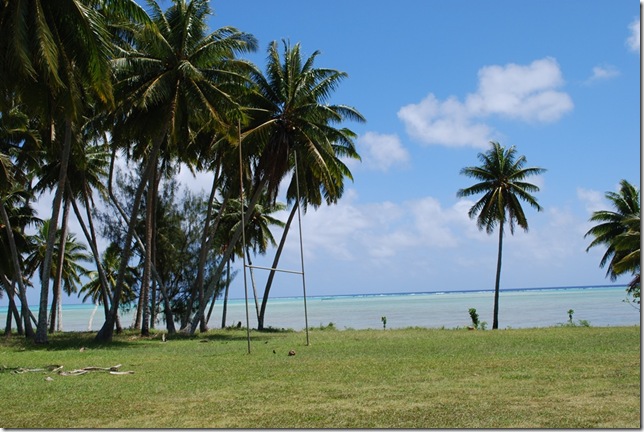Ahhh. Every time we write about how beautiful someplace is, we go and move to someplace at least as incredible and we’re all out of fresh adjectives. The passage to Aitutaki, Cook Islands went reasonably well. Waiting for the weather paid off, and the wind consistently worked its way from near the beam to dead astern, with the seas eventually following and the motion improving. It did continue to blow pretty good, and we made great time with just the full jib up all the way. Aitutaki was in view when the sun came up Friday morning, just as we’d hoped.
Approaching Aitutaki from the north
We did have a couple of small adventures along the way. We have a pretty dry boat, and with all the downwind sailing of late, it’s been really dry. But after leaving Mopelia we had a large wave from the port beam that crested at just the right time to send the equivalent of several buckets of water flying over the deck and into the cockpit. We even had a gallon or so fly straight through the salon door onto the starboard settee. The area of the salon floor near there seemed to be staying wet for a long time, and the next day Tiff pulled up the rug, did a little investigating, and found that our escape hatch had broken and was letting water into the salon as waves smashed up against the bottom of the bridgedeck. The hatch is mandated by international safety regulations and is designed to allow you to leave the boat easier in the event of a capsize. We also joke that it’s our equivalent of the glass in the floor featured in the ultra-riche, over-the-water bungalows in Bora Bora. Unfortunately, the latch on one handle had broken and the piece that the handle latches to was missing on the other side. A 2.5 sq ft hole in the boat makes things a little wet when there’s a good swell running, so something had to be done. Even if we’d stopped the boat, we didn’t have all the replacement parts, and it needs to dry out to be repaired properly anyway, so after several futile attempts, I finally came up with a method of keeping it shut by tying lines from the handles to a point on the boat above it and then using screwdrivers to twist the lines tight. That was good for the last 200 miles or so. I think we have a spare latch on board, and we should be able to work something out for the other side while we’re here.
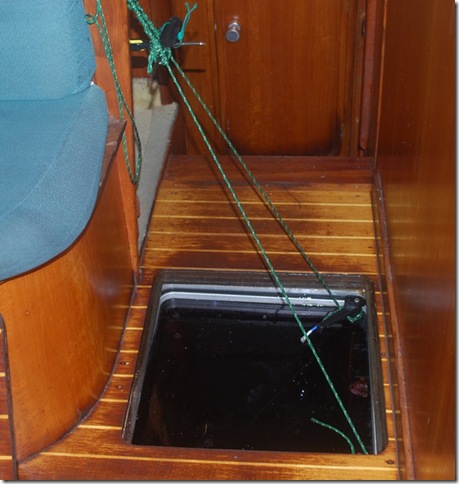 A little line, a couple screwdrivers,…
A little line, a couple screwdrivers,…
The pass and anchorage in Aitutaki makes the pass in Mopelia seem trivial. The pass here is just as narrow, but man-made, longer, and much shallower. We took our time getting in and anchoring in a tight spot with less than a foot of water under the port keel. We thought we understood from the boat beside us that the tide was low, but it wasn’t, and the port keel is now bumping occasionally. Luckily the bottom underneath it is sandy, and the rudder is in enough water, so we’re fine. Tomorrow there’s a boat leaving the sort of quay nearby, and we’ll move in to tie stern-to with an anchor out and lines run to palm trees.
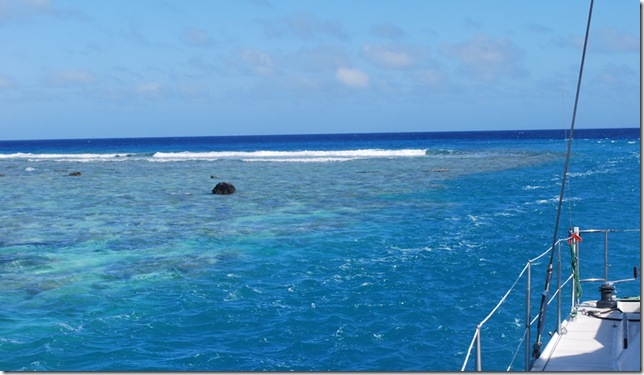 You can see how close we are to the edge of the pass as well as the churned-up water
You can see how close we are to the edge of the pass as well as the churned-up water
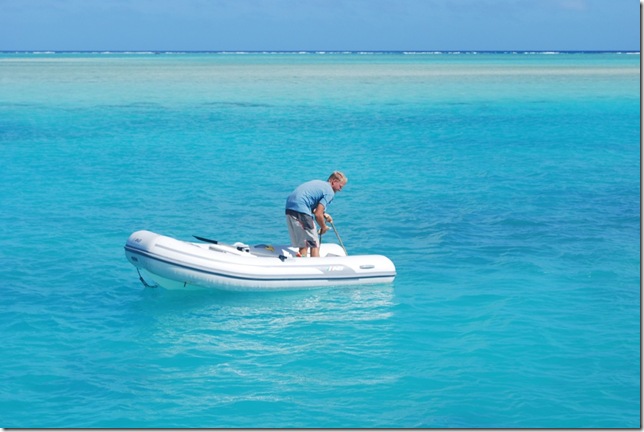 Setting a stern anchor amid a palette of blues
Setting a stern anchor amid a palette of blues
The island itself is an almost-atoll, which means it’s mostly an atoll (motus & lagoon) but also has a low (max height maybe 250 ft) main island that is inside the lagoon. Evidently the lagoon here is world-renowned for it’s beauty and landed Aitutaki on one of those US “places you must see before you die” lists. The Cook Islands are now an independent nation in free association with New Zealand, which basically means that New Zealand subsidizes the government budget and is ultimately responsible for Cook Islands foreign affairs and defense. We were a bit surprised to see several boats filled with Kiwi tourists heading out for lagoon excursions not too long after we’d set the anchor.
We got an earful of how great this place is from S/V Dreamtime on our way in, and by the end of the day we agreed. For starters, they speak English. We’d been in French Polynesia so long that we’d really become accustomed to getting around with a limited vocabulary and ability to understand things. It’s so much easier to get around and get things done when you’re fluent in one of the local languages. Dreamtime warned us that the customs guy was not in today and the agricultural inspector would seize all of our fresh fruits and vegetables, so we radioed back to the boat to give Wes and Tiff a heads-up so they could eat or hide them. The policy appears to be partly due to the association with New Zealand, which is also very strict, and partly due to their wanting to keep the islands as they are, relatively free of pests and plant diseases. That’s fair enough.
The woman at the harbor master’s office couldn’t reach anyone on the phone for us to check in with, but both the health and agricultural inspector found us at the same time while we were checking out the town. The health inspector had the form with the same questions that are asked at every port (has anyone died? any cases of cholera or plague? etc.) Cruise ships do occasionally have bodies on board, but for a small yacht they’re always funny questions. He got a laugh out of how quickly I was able to answer no all of them. The agricultural inspector had his kid with him and was in a bit of a hurry. At first, he insisted he’d have to come on board since we may have some tomatoes and a pamplemousse. When I told him Wes and Tiff were eating the pamplemousse for lunch, he eventually gave me a nudge and said “None” in reference to the form. Good enough for me. It was $20 NZ for each inspector and before I let the agricultural inspector go, I said “One more thing.” “Yes?” he asked. “How do you say hello in the local language?” We both just started laughing and laughing. All this business about tomatoes and he hadn’t bothered to say hello. “Kia Orana” is the answer, which sounds almost identical to the “Io orana” used in the Society Islands.
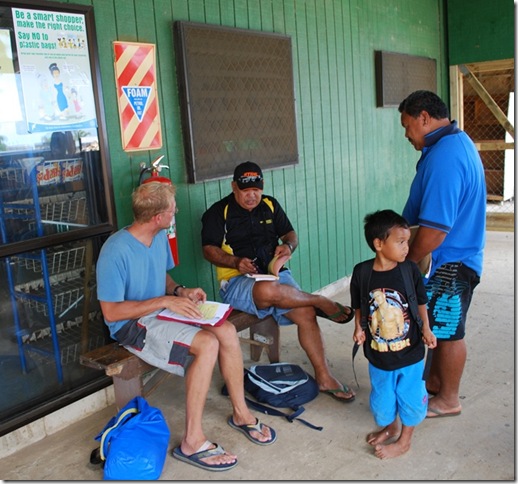 The health and agricultural officers caught up with us at the gas station
The health and agricultural officers caught up with us at the gas station
We spent some time walking around the island, finding an internet connection, and enjoying the beautiful island and weather as well as the friendly people. It’s not a rich place, but they seem to do a reasonable tourist business, things are generally well-kept, and the people seem good-natured. We were able to change the bond money we got back in Polynesian francs into New Zealand dollars, which was interesting, as the teller didn’t seem to comfortable with the calculator and exchange rates. Luckily the manager was there and everything worked out fine. The walk back to the boat was shortened by a cool guy who saw us walking and gave us a lift in the back of his truck. Almost everyone here is either on a scooter or riding in the back of a pick-up (the guy that picked us up had a 2×6 bolted in as a seat in the back of his pick-up).
For now, we’re just feeling lucky to be anchored in another beautiful lagoon enjoying the sunset by an island with friendly English-speakers and all the necessities (possibly including propane as well).



